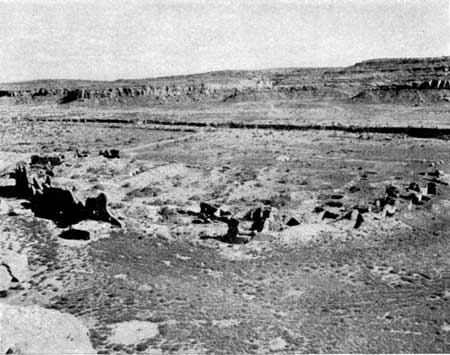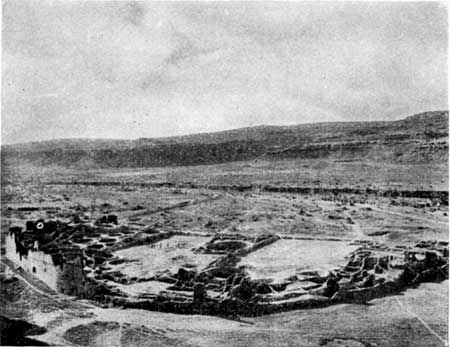![]()
MENU
|
Glimpses of Our National Monuments CHACO CANYON NATIONAL MONUMENT |

Pueblo Bonito in Chaco Canyon before excavation.
Copyrighted National Geographic Society. Reproduced by special
permission.
As examples of primitive architectural skill the 18 major ruins of Chaco Canyon National Monument, N. Mex., are without equal in the United States. Together with the cultural material recovered from their abandoned rooms, these ruins represent the very zenith of pueblo civilization in prehistoric times. No other archeological area in the entire Southwest exhibits so high a development. The ancient inhabitants of Chaco Canyon left no written record; no interpretable hieroglyphic system. The first published description of the Chaco Canyon ruins is that of Lieut. J. H. Simpson, in 1850; the second, that of W. H. Jackson, in 1879. Mexican and Indian guides accompanying Simpson gave the ruins the names by which they are now known.
Pueblo Bonito (beautiful village), the largest of the ruins, is an immense semicircular structure 520 feet long by 310 feet in its greatest north and south depth. Portions of fourth-story masonry are still standing. The older section of Pueblo Bonito appears to be the first terraced communal building erected in Chaco Canyon; the newer sections, built by a different people but occupied contemporaneously with the older, embrace the finest aboriginal masonry north of Mexico. The National Geographic Society intensively explored Pueblo Bonito from 1921 to 1927. The cultural material gathered during these investigations has been presented to the National Museum in Washington. The scientific reports recording these seven expeditions are now in preparation.
Pueblo Bonito covers more than 3 acres of ground; in its heyday, it contained about 800 rooms and 32 kivas or ceremonial chambers. Neil M. Judd, of the United States National Museum, who conducted the excavations for the National Geographic Society, characterizes Pueblo Bonito as the largest apartment house built anywhere in the World prior to about 1887, and estimates that at one time it housed 1,200 people. These were peaceful farmer folk who cultivated near-by fields of maize, beans, and squash. The Bonitians had no metal tools, no domestic animals except dogs and turkeys. The society's explorations have fixed the abandonment of Pueblo Bonito at approximately 1,000 years ago.

Pueblo Bonito after excavation.
Copyrighted National Geographic Society. Reproduced by special
permission.
Pueblo del Arroyo, a few hundred yards west of Pueblo Bonito, has also been explored by the National Geographic Society. It is a compact E-shaped structure, 275 feet north and south by 225 feet wide. Its single court is inclosed by a concave series of rooms to the eastward. Unlike its larger, more important neighbor, Pueblo del Arroyo does not evidence successive periods of reconstruction. Built and abandoned during the decadent years of Pueblo Bonito, the "village by the arroyo" was relatively short lived.
On top of the mesa, about three-fourths of a mile north of Pueblo Bonito, are the ruins of Pueblo Alto (high village), consisting of two community houses, the smaller about 75 feet square.
Chettro Kettle (rain pueblo) measures 440 by 250 feet. Its masonry is exceptionally good and consists of fine-grained sandstone broken into small tabular pieces and laid in thin mortar. As in the other Chaco ruins, Courses of heavier stone frequently occur in parallel bands, giving a pleasing ornamental effect.
Hungo Pavi (crooked nose), 2 miles above Pueblo Bonito, is built on three sides of a court, a semicircular row of rooms forming the fourth side. The main building is 309 feet long and each of the two wings 136 feet.
Una Vida (single [one] life), about 2 miles east of Hungo Pavi, is L-shaped, the extremities of the two wings being connected by a semicircular wall. The ruin is badly demolished.
Wijiji, 1 mile above Una Vida, is rectangular, 225 by 120 feet, built around three sides of a court, with no wall on the fourth.
Casa Rinconada, on the south of the canyon, opposite Pueblo Bonito, is an enormous double-walled kiva or ceremonial room 72 feet in diameter with walls 30 inches thick. The outer wall is 8 feet from the inner, the space between being divided into rooms. Tsin Kletzin is a small communal house on the mesa, a mile to the south.
Kin Kletsoi (yellow house) is a small pueblo half a mile west of Bonito. Another mile down is Casa Chiquita (little house).
Peñasco Blanco (white rock point), situated on a high mesa (west of the arroyo) 3 miles west of Pueblo Bonito, is one of the most striking of the ruins. Elliptical in outline, its long diameter is 500 feet, its short 365 feet. It was originally four stories high. Portions of third-story walls still stand but the lower rooms are almost wholly covered by fallen masonry and the wind-blown débris accumulated about it.
Kin Klizhin (the black house), 3 miles south and 5 miles west of Pueblo Bonito, and Kin Binioli (whirlwind pueblo), 10 miles west and 4 miles south, are well preserved ruins belonging to the principal Chaco Canyon culture. Near each of these the remains of extensive irrigation works are traceable.
Pueblo Pintado (painted village) is the most easterly ruin. It stands on the Continental Divide and overlooks a rolling plateau whereon the Navajo Indians graze flocks of sheep and mottled goats. Casa Morena (brown house) and Kin Yai, near the Indian school at Crownpoint, complete the important ruins in the monument. In addition to these, however, the keen student of archeology can point out the disintegrating remains of hundreds of lesser structures some of which were built after abandonment of Pueblo Bonito while others were constructed at that early date when Pueblo peoples were just coming to adopt reasonably permanent habitations.
The Chaco Canyon is most accessible from Thoreau, on the Santa Fe Railroad and National Old Trails Highway, or U. S. Highway 66, connecting Albuquerque and Gallup, N. Mex. From Thoreau the road passes north through Satan's Pass to Crownpoint, where is located the Eastern Navajo Indian School and Agency. It is about 25 miles from Thoreau to Crownpoint and 40 miles from Crownpoint to the monument. Most travelers prefer to start their journey from Gallup, where several comfortable hotels are to be found. The road is marked, and during dry weather is always passable. The Chaco Canyon Trading Co. operates a small store near the monument, where a supply of foodstuffs and other tourists' supplies are carried. Gus Griffin, whose address is Crownpoint, N. Mex., operates the Pueblo Bonito Lodge, which has limited accommodations for visitors.
Hilding Palmer, whose address is Crownpoint, is custodian of the monument.
A bridge built in 1928 eliminates the danger formerly experienced in crossing the Chaco arroyo during the summer rainy season.
The State expects to do some work on the road from Crownpoint to the monument during 1930. From the monument north a good graded dirt road 26 miles in length leads to the main highway between Albuquerque and Aztec Ruins National Monument, from which point a graded highway leads to Mesa Verde National Park.
The national monument was created March 11, 1907, and contains 21,512 acres.
|
|
Last Modified: Thurs, Oct 19 2000 10:00:00 pm PDT
glimpses2/glimpses5.htm

 Top
Top